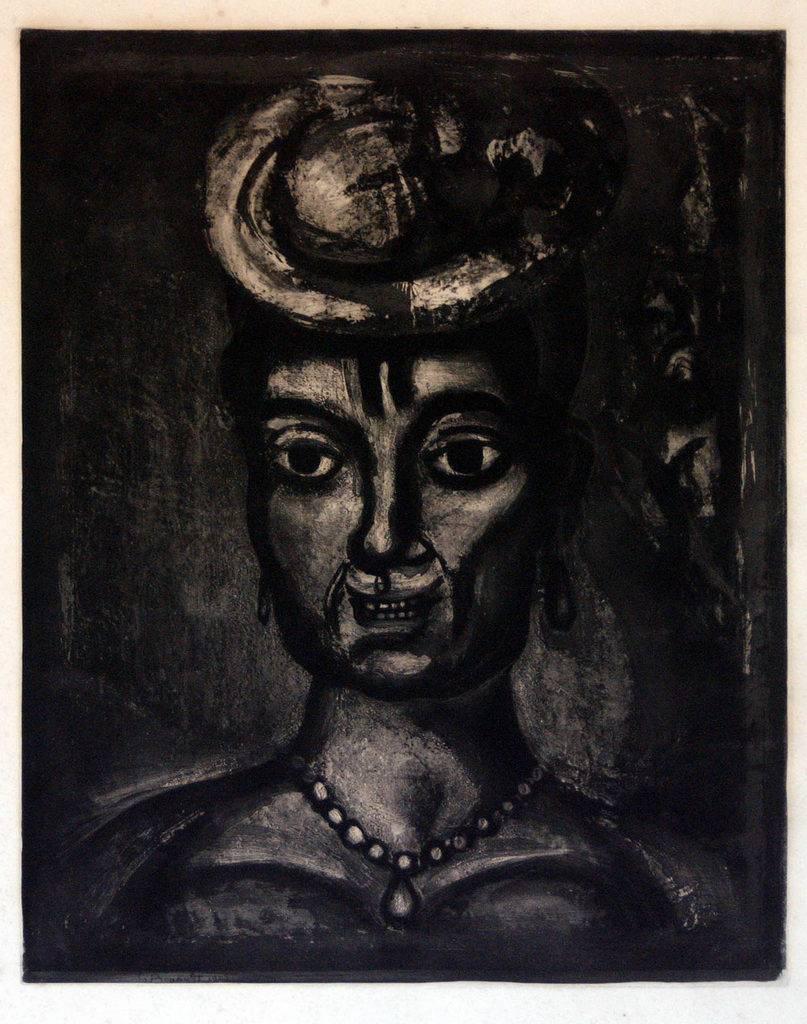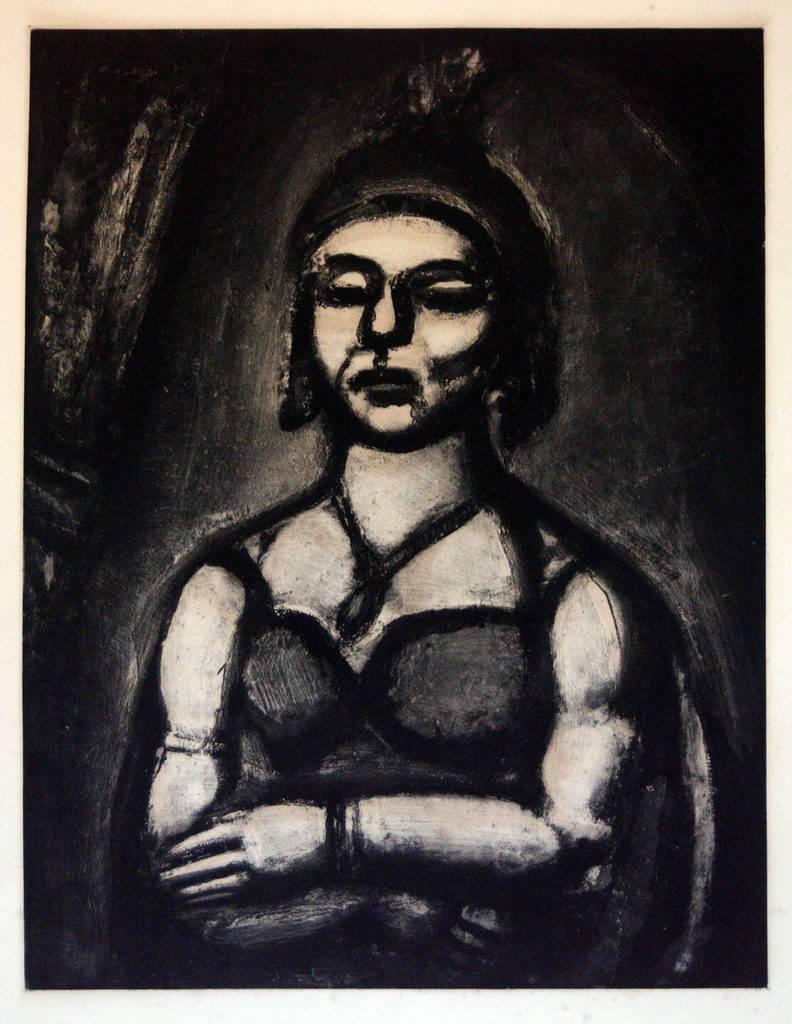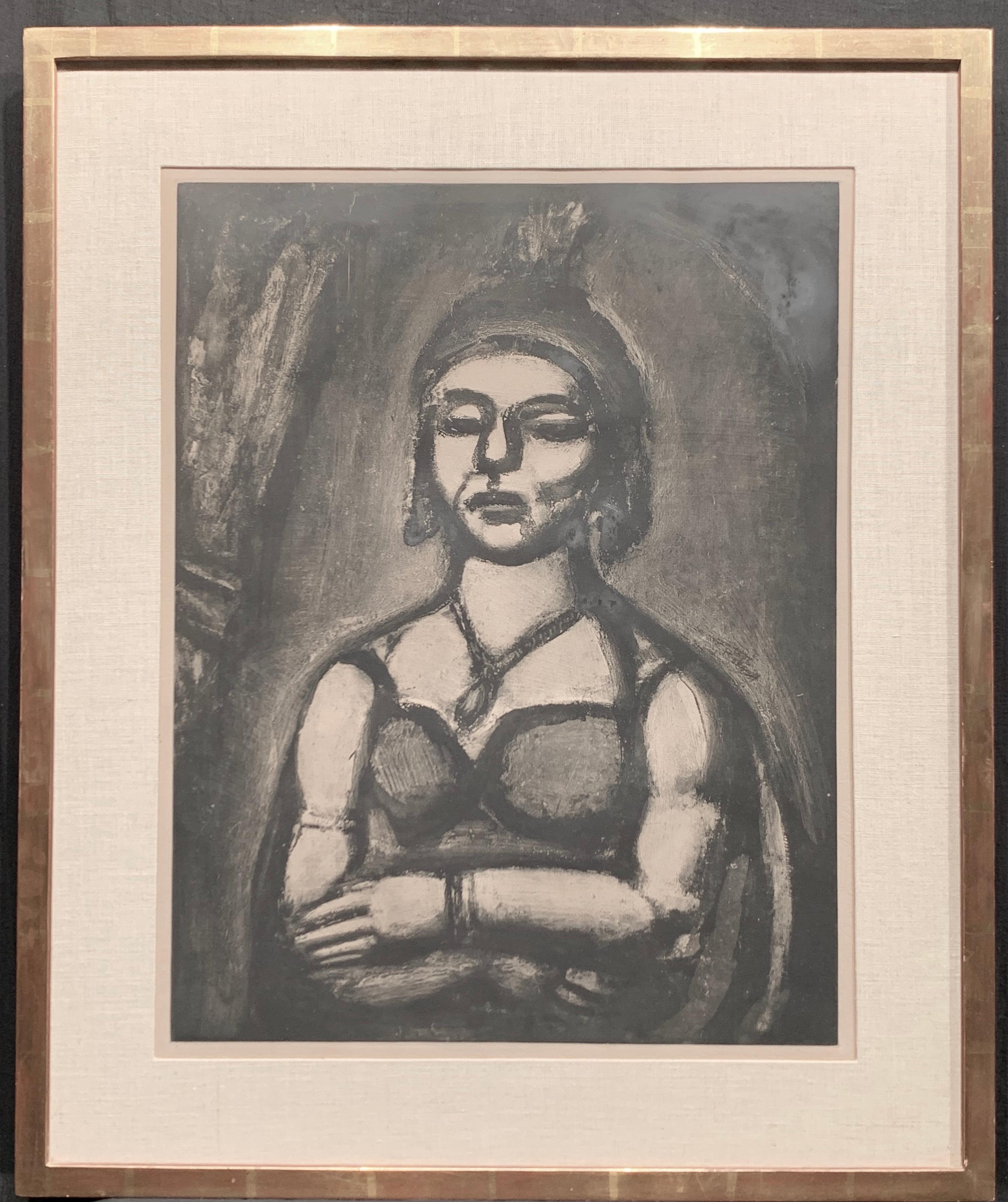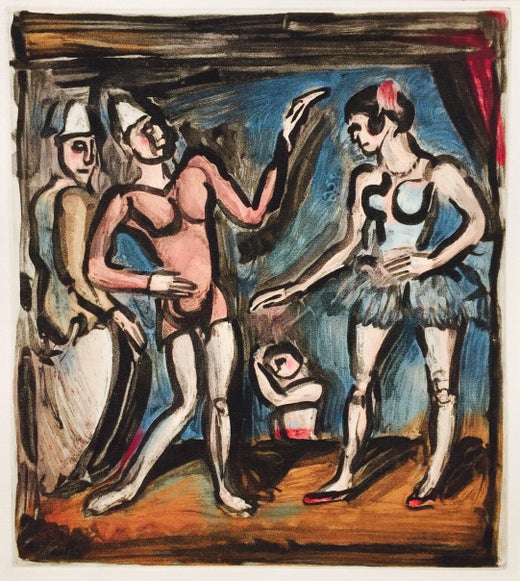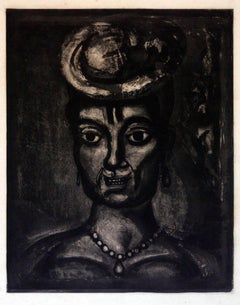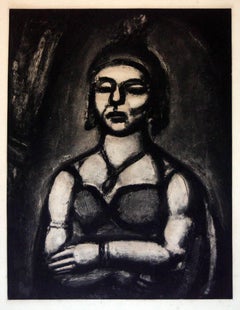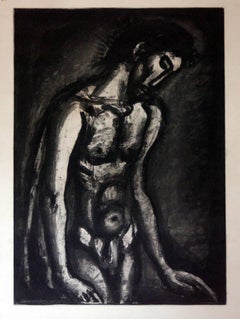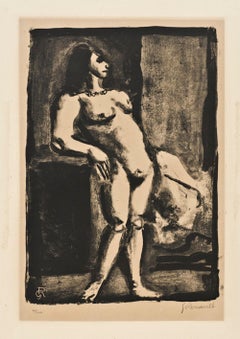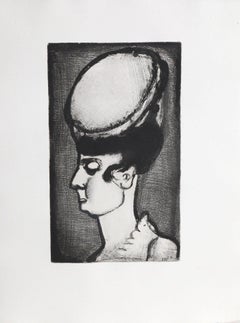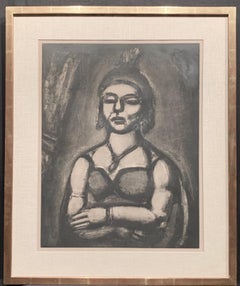Items Similar to Femme Affranchie A' Quatorze Heures Chante Midi - Georges Rouault
Want more images or videos?
Request additional images or videos from the seller
1 of 5
Georges RouaultFemme Affranchie A' Quatorze Heures Chante Midi - Georges Rouault1948
1948
$3,312.85
£2,504.60
€2,800
CA$4,632.17
A$5,062.43
CHF 2,664.01
MX$60,635.30
NOK 33,529.24
SEK 31,315
DKK 21,331.71
About the Item
Signed on plate.
Edition of 450 prints, belonging to the suite “Miserere”, considered as the most important religious graphic work of XX century. The single prints, realized with a sophisticated mixed technique, were designed between 1916 and 1927, and finally published as a suite in 1948.
Image Dimensions : 55.5 x 43 cm
- Creator:Georges Rouault (1871-1958, French)
- Creation Year:1948
- Dimensions:Height: 25.6 in (65 cm)Width: 19.89 in (50.5 cm)Depth: 0.04 in (1 mm)
- Medium:
- Movement & Style:
- Period:
- Framing:Framing Options Available
- Condition:Insurance may be requested by customers as additional service, contact us for more information.
- Gallery Location:Roma, IT
- Reference Number:Seller: J-448001stDibs: LU65036424602
Georges Rouault
Executed in 1937, Carlotta belongs to a group of portraits of members of society. Unlike Picasso and Toulouse-Lautrec, who portrayed these individuals with pathos, Rouault’s approach was unapologetic and raw. In the present work several layers of pigment can be discerned; the build-up of translucent and opaque layers of paint creates a three-dimensionality that characterizes the artist’s strongest work. Furthermore, the work is highlighted by the deep swaths of black delineating the subject, representing a signature element of Rouault’s portraiture of this period.
About the Seller
4.9
Platinum Seller
Premium sellers with a 4.7+ rating and 24-hour response times
1stDibs seller since 2017
7,833 sales on 1stDibs
Typical response time: 1 hour
- ShippingRetrieving quote...Shipping from: Roma, Italy
- Return Policy
More From This Seller
View AllFemme Affranchie A' Quatorze Heures Chante Midi
By Georges Rouault
Located in Roma, IT
Signed on plate.
Edition of 450 prints, belonging to the suite “Miserere”, considered as the most important religious graphic work of XX century. The single prints, realized with a s...
Category
1940s Post-Impressionist Figurative Prints
Materials
Etching
Des Ongles Et Du Bec
By Georges Rouault
Located in Roma, IT
Edition of 450 prints, belonging to the suite “Miserere”, considered as the most important religious graphic work of XX century.
The single prints, realized with a sophisticated mixe...
Category
1940s Post-Impressionist Figurative Prints
Materials
Etching
Il a été maltraité et opprimé et il n'a pas ouvert la bouche - from "Miserere"
By Georges Rouault
Located in Roma, IT
Wonderful original etching with aquatint realized by Georges Rouault between 1916 and 1923, published as a suite in 1948. Sheet in perfect conditions.
The artwork is part of the important suite Miserere realized by Rouault between 1917 and 1923, considered as the most important religious graphic of XX century. Il a été maltraité et opprimé et il n'a pas ouvert la bouche represents an episode of Christ's passion. Miserere suite is divided in two themes: religious and profane; one is linked to Christ's passion and the other is dedicated to the human event, to the pilgrimage of pain on earth, made even more tragic by war. In the 58 original plates, Rouault lingers on the conditions of humanity. Like few other contemporaries, Rouault represents man, placing him at the center of an absurd and squalid theater. Interesting the use of contrasts and the shapes of the figures with black outlines. In this artwork the figure of Christ is placed in the center facing down.
Georges Rouault (Paris, 1871) has been an interesting exponent of French Expressionism...
Category
1940s Modern Figurative Prints
Materials
Etching
La Fille - Original Lithograph by Georges Rouault
By Georges Rouault
Located in Roma, IT
Original lithograph, edited in 100+25 pieces numbered and hand signed.
3rd statem, the first with monogram printed on plate lower left.
Very good conditions.
Published in the Catalogue "Georges Rouault: Oeuvre Gravé", by Isabella Rouault and François Chapon n. 320, p. 278
Georges Rouault (Paris, 1871) has been an interesting exponent of French Expressionism...
Category
1920s Modern Figurative Prints
Materials
Lithograph
L'Ecuyère - Lithograph by Georges Rouault - 1920
By Georges Rouault
Located in Roma, IT
L'Ecuyere is a beautiful original lithograph realized by Georges Rouault in 1920.
Hand-signed and numbered by the artist in pencil.
Edition of 25 prints.
5th ad final state of a s...
Category
1920s Modern Figurative Prints
Materials
Lithograph
$1,242 Sale Price
30% Off
Eve Déchue - Lithograph by Georges Rouault - 1940s
By Georges Rouault
Located in Roma, IT
Hand signed and numbered. Third state, edition of 10 plus some artist proofs, signed.
Hand signed and numbered in pencil.
Very good condition.
Reference Catalogue Raisonné: "George...
Category
1940s Modern Figurative Prints
Materials
Lithograph
$1,490 Sale Price
30% Off
You May Also Like
Femme Hideuse from The Reincarnations du Pere Ubu, by Georges Rouault
By Georges Rouault
Located in Long Island City, NY
Femme Hideuse from The Reincarnations du Pere Ubu
Georges Rouault, French (1871–1958)
Date: 1928
Etching with Aquatint, signed in the plate
Image Size: 12 x 8 inches
Size: 17 x 13 in...
Category
1920s Expressionist Figurative Prints
Materials
Etching, Aquatint
Femme Nue Vero la Gauche from The Reincarnations du Pere Ubu, by Georges Rouault
By Georges Rouault
Located in Long Island City, NY
Femme Nue Vero la Gauche from The Reincarnations du Pere Ubu
Georges Rouault, French (1871–1958)
Date: 1928
Etching with Aquatint, signed in the plate
Image Size: 12 x 8 inches
Size:...
Category
1920s Expressionist Figurative Prints
Materials
Etching, Aquatint
Mademoiselle Irma from The Reincarnations du Pere Ubu, by Georges Rouault
By Georges Rouault
Located in Long Island City, NY
Mademoiselle Irma from The Reincarnations du Pere Ubu
Georges Rouault, French (1871–1958)
Date: 1928
Etching with Aquatint, signed in the plate
Image Size: 12 x 8 inches
Size: 17 x 1...
Category
1920s Expressionist Figurative Prints
Materials
Etching, Aquatint
Des Ongles et Du Bec (abstract female portrait)
By Georges Rouault
Located in Wilton Manors, FL
Artist Georges Rouault
(1871, France - 1958, France)
Main title
"Des ongles et du bec"
Etching and aquatint on wove paper.
Creation date
1926 / 1948
Publisher: Etoile Filante, P...
Category
Mid-20th Century Abstract Abstract Prints
Materials
Etching, Aquatint
$990 Sale Price
44% Off
Vierge aux sept glaives (The Virgin pierced by seven swords) (Sorrowful Mother)
By Georges Rouault
Located in Fairlawn, OH
Vierge aux sept glaives (The Virgin pierced by seven swords) (Sorrowful Mother)
Aquatint, drypoint, roulette and burnishing over heliogravure, 1926
Unsigned as issued
From: Miserere ...
Category
1920s French School Figurative Prints
Materials
Aquatint
Fille dite de joie (They Call Her Daughter of Joy)
By Georges Rouault
Located in Fairlawn, OH
Fille dite de joie (They Call Her Daughter of Joy)
Aquatint, drypoint, roulette and burnishing over heliogravure, 1922-1927
Unsigned (as issued)
From: Miserere (Have Mercy), 58 plate...
Category
1920s French School Figurative Prints
Materials
Aquatint
More Ways To Browse
Prescott Chaplin
Raphael Et La Fornarina
Ray Euffa
Rc Gorman Print
Reiss Studio
Riccardo Tommasi Ferroni On Sale
Robert Heindel
Roberto Matta Erotic
Robin Tanner On Sale
Rolex Radium Dial
Rolf Weijburg
Roy Lichtenstein Hopeless
Roy Lichtenstein Pyramids
Ruth Starr Rose
Ryan Hewett
S L Margolies
Salvador Dali Bull
Salvador Dali Fallen Angel
